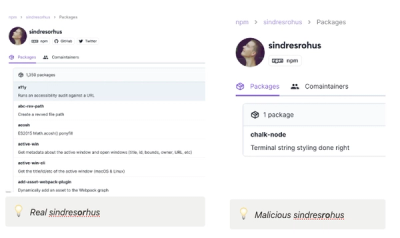
Security News
JSR Working Group Kicks Off with Ambitious Roadmap and Plans for Open Governance
At its inaugural meeting, the JSR Working Group outlined plans for an open governance model and a roadmap to enhance JavaScript package management.
Container for finite state machines or in other words - a tool for state management based on state machines.
The library is available as a npm module so npm install stent will do the job. There's also a standalone version here (only core functionalities) which you can directly add to your page.
State machine is a mathematical model of computation. It's an abstract concept where the machine has different states. It accepts input and based on which (plus its current state) transitions into another state. Isn't it sounds familiar? Yes, it is sounds like a front-end application. That's why that model/concept applies nicely to UI development.
Disclaimer: there are different types of state machines. The one that fits in my use case is Mealy finite state machine.
To create a new machine we simply import the Machine object and call its create method.
import { Machine } from 'stent';
const machine = Machine.create('name-of-the-machine', {
state: { name: 'idle' },
transitions: {
'idle': {
'run': 'running'
},
'running': {
'stop': 'idle'
}
}
});
The machine above has two possible states idle and running. When we are at the idle state (the default one) there is only one acceptable action/input run. It transitions the machine to a running state. The running state does not accept run but only stop action. If fired we are going back to the idle state.
Stent library is enforcing declarative approach of programming. Which means that by defining the possible states and actions in one place we clearly script what happens in our app without actually doing it. After that the machine knows what to expect and automatically creates a couple of things for us so we can trigger the logic. Based on the transitions property we have:
idle state produces isIdle() method, for running we have isRunning().run() and stop().We may use spaces or dashes in the state or action names but the rule of thumb is that Stent transforms the string to a camel case. For example if we have fetching data state the machine will have isFetchingData() method, get fresh todos action will result into getFetchTodos() method.
So, here's an example of how to use the machine above:
if (machine.isIdle()) {
machine.run();
}
if (machine.isRunning()) {
machine.stop();
}
console.log(machine.isIdle()); // true
Of course, this doesn't make a lot of sense but we see the available methods.
The created machine may accept more then a string as a handler of the action. We may pass a function which accepts two arguments. The first one is the current state and the second one is some meta data traveling with the action (if any). For example:
const machine = Machine.create('todo-app', {
state: { name: 'idle', todos: [] },
transitions: {
'idle': {
'add todo': function (state, todo) {
return {
name: 'idle',
todos: [...state.todos, todo]
};
}
}
}
});
machine.addTodo({ title: 'Fix that damn bug' })
The state in the context of Stent is a vanilla JavaScript object literal. The only one reserved property is name which represents the state's name. Everything else depends on our business logic. In the example above that's the todos array.
The handler function accepts the previous state and should return a new state in a immutable fashion. Same as the Redux's reducer, whatever we return becomes the new state.
The actual todo item is passed to the addTodo method of the machine and comes as a second argument of the handler.
Stent also accepts a generator function as a handler. That's inspired by the redux-saga project. The generators have couple of interesting characteristics and this library uses two of them - the ability to generate multiple results from a single function and the ability to pause the execution.
What if we need to fetch data from the server and want to handle that process with multiple states - idle, fetching, done or error. Here's how to do it with a generator as a handler:
const machine = Machine.create('todo-app', {
state: { name: 'idle', todos: [] },
transitions: {
'idle': {
'fetch todos': function * () {
yield { name: 'fetching' };
try {
const todos = yield call(getTodos, '/api/todos');
} catch (error) {
return { name: 'error', error };
}
return { name: 'done', todos };
}
}
}
});
Assuming that getTodos is a function that accepts an endpoint and returns a promise. Inside the generator we are allowed to yield two type of things:
call. (more about those helpers below)Generator as an action handler is suitable for the cases where we do more then one thing and/or have async operations.
<state object>The state object is just a normal object literal. The only one required property is name and it is used to indicate the state of the machine:
{
name: 'idle',
user: {
firstName: '...',
lastName: '...'
},
someOtherProperty: '...'
}
Machine.<create|get|flush>The Machine object is used for creating and fetching machines.
import { Machine } from 'stent';
const appMachine = Machine.create(
'app', // name of the machine
{
state: <state object>,
transitions: {
<state name>: {
<action name>: <action handler>,
<action name>: <action handler>,
...
},
<state name>: {
<action name>: <action handler>,
<action name>: <action handler>,
...
},
...
}
}
);
// later in the code
const appMachine = Machine.get('app');
The created machine has dynamically created methods associated with the provided configuration:
is<state name> method so we can check if the machine is in that state. For example, to check if the machine is in a fetching remote data state we may call machine.isFetchingRemoteData() method. The laternative is machine.state.name === 'fetching remote data'.add new todos is available as machine.addNewTodo(<todo data here>).Machine.flush() can be used to delete the currently created machines.
<action handler>The action handler may be just a string. In the following example fetching is the same as { name: 'fetching' } state object.
Machine.create('app', {
'idle': {
'fetch data': 'fetching'
}
});
Could be also a state object:
Machine.create('app', {
'idle': {
'fetch data': { name: 'fetching', data: [], pending: false }
}
});
Another variant is to use a function that returns a string. Which again results in { name: 'fetching' }.
Machine.create('app', {
'idle': {
'fetch data': function (state, payload) {
return 'fetching';
}
}
});
Notice that the function receives the current state and some payload passed when the action is called.
And of course we may return the actual state object. That's actually a common case because very often we want to keep some data alongside:
Machine.create('app', {
'idle': {
'fetch data': function (state, payload) {
return { name: 'fetching', answer: 42 };
}
}
});
The context of the action handler function (or generator) is the machine itself. This means that this inside the function points to the created machine and we may call its methods. For example:
Machine.create('app', {
'idle': {
'fetch data': function (state, payload) {
if (this.isIdle()) {
this.request('/api/todos');
}
},
'request': function (endpoint) {
console.log(endpoint); // endpoint = /api/todos
}
}
});
In some cases you don't want to change the state but only handle the action. So feel free to skip the return statement. If the handler returns undefined the machine keeps its state.
We may also use a generator if we have more complex operations or/and async tasks.
Machine.create('app', {
'idle': {
'fetch data': function * (state, payload) {
yield 'fetching'; // transition to a `fetching` state
yield { name: 'fetching' } // the same but using a state object
}
}
});
More for generators and what could be yielded in the Helpers used inside generators section below.
connectconnect is the short way to do Machine.get and retrieving one or more created machines.
import { connect } from 'stent/helpers';
Machine.create('MachineA', ...);
Machine.create('MachineB', ...);
connect()
.with('MachineA', 'MachineB')
.map((MachineA, MachineB) => {
// called multiple times
});
The mapping function by default is called once and then every time when the state of the connected machines changes. So, if you need only that first call use mapOnce instead.
connect()
.with('MachineA', 'MachineB')
.mapOnce((MachineA, MachineB) => {
// this gets called only once
});
There's also a helper for integration with React. It creates a HOC:
import React from 'react';
import { connect } from 'stent/react';
class TodoList extends React.Component {
render() {
const { todos, error, isFetching, fetchTodos, deleteTodo } = this.props;
...
}
}
// `todos` and `authorization` are machines defined
// using `Machine.create` function
export default connect(TodoList)
.with('MachineA', 'MachineB')
.map((MachineA, MachineB) => {
isIdle: MachineA.isIdle,
todos: MachineB.state.todos
});
The result of the map function goes as props to our component. Similarly to Redux's connect function.
yield call(<function>, ...args)It's blocking the generator function and calls <function> with the given ...args. <function> could be:
import { call } from 'stent/helpers';
Machine.create('app', {
'idle': {
'fetch data': function * () {
const data = yield call(requestToBackend, '/api/todos/', 'POST');
}
}
});
requestToBackend is getting called with /api/todos/ and POST as arguments.
yield wait(<action name/s>)It's blocking the generator and waits for action/s. The function accepts a single argument string or array of strings.
import { wait } from 'stent/helpers';
Machine.create('app', {
'idle': {
'fetch data': function * () {
const initActionPayload = yield wait('init');
const [ userProfilePayload, dataPayload ] = yield wait([
'user profile fetched',
'data processed'
]);
...
}
}
});
If you want to extend the library with some additional functionalities you may add a middleware. It's an object with a set of functions that hook to the lifecycle methods of Stent.
import { Machine } from 'stent';
Machine.addMiddleware({
onActionDispatched(next, actionName, ...args) {
console.log(`Action dispatched: ${ actionName }`);
next();
console.log(`After ${ actionName } action our state is ${ this.state.name }`);
},
onStateChanged(next) {
console.log(`The new state will be: ${ this.state.name }`);
next();
console.log(`The state now is: ${ this.state.name }`);
}
});
The hooks above are getting called just before running the internal Stent's logic. At this moment nothing in the machine is changing/executing. Calling next will pass the control flow to Stent.
From idle to fetching by using fetch data action.
// Just pass the new state as a handler for an action
Machine.create('app', {
'idle': {
'fetch data': 'fetching'
}
});
// Return a string in the handler
Machine.create('app', {
'idle': {
'fetch data': function () {
return 'fetching';
}
}
});
// Return a state object
Machine.create('app', {
'idle': {
'fetch data': function () {
return { name: 'fetching' };
}
}
});
// Yield a string in the handler's generator
Machine.create('app', {
'idle': {
'fetch data': function * () {
yield 'fetching';
// or you can yield a state object
// `yield { name: 'fetching' }`
}
}
});
For the cases where you want to do something as a result of two (or more) actions. From idle state to done when fetching in progress and success (or fail) actions are dispatched.
Machine.create('app', {
'idle': {
'fetching in progress': function * () {
const [ data, error ] = yield wait(['success', 'fail']);
// or just `const data = yield wait('success')`
// if we are interested only in one action
return data ? { name: 'done', data } : { name: 'done', error };
}
}
});
This example is a bit silly. We'll probably go with a separate state when data fetching is in progress.
import { Machine } from 'stent';
const machine = Machine.create('app', {
state: { name: 'idle', todos: [] },
transitions: {
'idle': {
'add new todo': function ({ todos }, todo) {
todos.push(todo);
return { name: 'idle', todos };
},
'delete todo': function ({ todos }, index) {
return { name: 'idle', todos: todos.splice(index, 1) };
},
'fetch todos': function * () {
yield 'fetching';
try {
const todos = yield call(getTodos, '/api/todos');
} catch (error) {
return { name: 'fetching failed', error };
}
return { name: 'idle', todos };
}
},
'fetching failed': {
'fetch todos': function * () {
yield { name: 'idle', error: null };
this.fetchTodos();
}
}
}
});
machine.fetchTodos();
import React from 'react';
import { connect } from 'stent/react';
class TodoList extends React.Component {
render() {
const { todos, error, isFetching, fetchTodos, deleteTodo } = this.props;
if (isFetching()) return <p>Loading</p>;
if (error) return (
<div>
Error fetching todos: { error }<br />
<button onClick={ fetchTodos }>try again</button>
</div>
);
return (
<ul>
{ todos.map(({ text}) => <li onClick={ deleteTodo }>{ text }</li>) }
</ul>
);
}
}
// `todos` and `authorization` are machines defined
// using `Machine.create` function
export default connect(TodoList)
.with('todos', 'authorization')
.map(({ state, isFetching, fetchTodos, deleteTodo }, { isAuthorized }) => {
todos: state.todos,
error: state.error,
isFetching,
fetchTodos,
deleteTodo,
isAuthorized
});
FAQs
Stent is combining the ideas of redux with the concept of state machines
The npm package stent receives a total of 1,689 weekly downloads. As such, stent popularity was classified as popular.
We found that stent demonstrated a not healthy version release cadence and project activity because the last version was released a year ago. It has 1 open source maintainer collaborating on the project.
Did you know?

Socket for GitHub automatically highlights issues in each pull request and monitors the health of all your open source dependencies. Discover the contents of your packages and block harmful activity before you install or update your dependencies.

Security News
At its inaugural meeting, the JSR Working Group outlined plans for an open governance model and a roadmap to enhance JavaScript package management.

Security News
Research
An advanced npm supply chain attack is leveraging Ethereum smart contracts for decentralized, persistent malware control, evading traditional defenses.

Security News
Research
Attackers are impersonating Sindre Sorhus on npm with a fake 'chalk-node' package containing a malicious backdoor to compromise developers' projects.